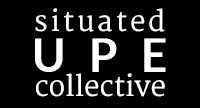What does it mean to teach a situated class? The easiest answer to this is to include ‘local’ examples. But for me, being deeply situated in my teaching has also meant starting from and responding to what the students know and helping them make sense of their own world. (In contrast to the typical academic textbook which is structured to present an academic field to students; it’s also in contrast to teaching what students ask for, for they often don’t know what they don’t know.)
After teaching from the well-used Robbins, Hintz and Moore volume, and asking my students at the University of Oklahoma to write weekly response papers, I realized that the course I was teaching simply wasn’t setting the students up to do much with the content. I tried tweaking and supplementing, but eventually resolved to write my own quasi-textbook and work through a series of real-world explanations for environmental problems. The open, online format (ok, it’s not yet open; I want to test-run it first) is also hoped to better enable place-situated approaches by making it easy to swap out examples and case studies.
I now have 10 weeks of text that presents different explanations for the fundamental, underlying cause(s) of environmental problems and the solutions that accompany such frames. The text has a few pages of explanation, accompanied by links to online examples of people speaking within these problem frames. The last 6 weeks will be focused on using these ideas to understand specific cases.
For many of my students, tackling environmental problems seems too momentous. Many are frustrated that we seem, as a society, to simply fail to act. I try to work from this reasonably common starting point to demonstrate that there are many different strategies for redressing environmental problems. And that while most people believe something needs to be done, we are often stuck with competing ideas about what to do, and what kind of world this would create. So, before solving problems, we need to carefully examine the assumptions and rationality of a problem frame, and why different solutions often seem to work against each other.
For example, lots of people are concerned about climate change. There are many different options out there. What can be done? Individual choices are the first way that many people try to create change. Maybe they change their lightbulbs, walk to work, and eat less meat. At a global scale, there are efforts to create carbon markets. This isn’t just a difference in scale or organization, though, in which some things are for individuals and others for officials. Officials only respond to the pressure put on them, a task that individuals join together to do! Individuals can help to create this change, by lobbying their representatives, participating in environmental NGOs, educating peers and children, and so on. A different approach is to invest in clean energy. This can again be through individual choice, purchasing a household solar panel. But it can also mean trying to get one’s own public electricity agency to increase the percentage renewable.
These choices- technology, markets, policy, green consumption- need to be recognized as different and not entirely compatible tactics. It’s easy to say that they are all good and people who care about the environment should just do them all, but that is quite a lot to ask. And some answers are contradictory: capitalism can’t be the problem and solution. If we believe that addressing the environment is both a bit of work and important, then we should be strategic about what we’re doing. We should think about what kinds of actions are going to give us the best result for our effort.
I’m going to experiment over the upcoming semester with this new structure, and let you know how it goes.
